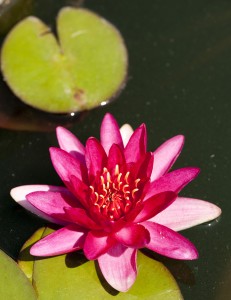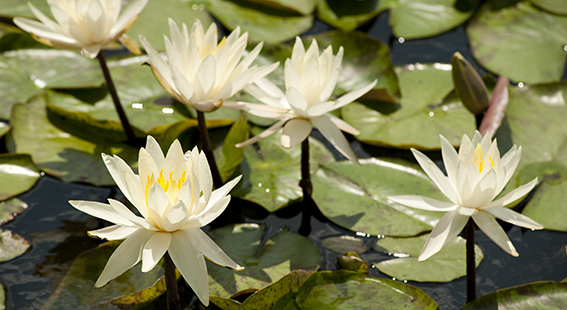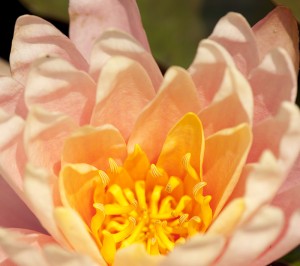Wondrous Water Lilies Continued…
Posted in Gardening Tips, Gardens and Collections on August 13 2013, by Sonia Uyterhoeven
Sonia Uyterhoeven is the NYBG‘s Gardener for Public Education.

Last week we discussed how to plant your water lilies. This week we will focus on the bloom. Water lilies flower for 3 – 5 days, with the bloom emerging from the murky depths on the first day, opening, and standing erect. On the second day, the flower starts to bend slightly, slouching more on the third day and falling back into the water by the fifth.
Once the bloom disappears back into the water, it is a good idea to take your hand and run it down the stem until you get close to the base, then either snap or cut it off. The water lily stem will start to get mushy as it ages, and sometimes a good tug is all you need.
In a pond situation, the flower head forms seeds that eventually find their home on the muddy floor of the pond. As a homeowner, however, you are probably interested in maximizing your bloom. Seed production takes energy away from flowering, so try to remove old flowers and foliage once a week to keep your water lily tidy and focused on producing flowers.
Flower facts to think about when buying water lilies:
- Tropical water lilies come in a rainbow of colors, including some spectacular blues and purples.
- Tropical water lilies tend to be larger than hardy water lilies. The flowers are larger, as well, and the stems hold the flower higher above the water’s surface.
- Tropical water lilies can be diurnal or nocturnal bloomers.
- Hardy water lilies come in shades of yellow, pinks, reds, pastel orange, and white.
- Some water lilies are called “changeables.” These flowers change their color as the bloom progresses, changing from any variation of pastel colors.

Some water lilies have beautiful fragrances.
There are many wonderful water lilies to choose from, so where do you start? Some easy to find varieties that are perfect for a container or small pond situation are the hardy dwarf water lilies such as Nymphaea pygmaea ‘Helvola’ (yellow), Nymphaea ‘Perry’s Double’ (white), N. ‘Chrysantha’ (pastel orange/pink), ‘Indiana’ (pink and yellow) and ‘Gloriosa’ (crimson red).
For fragrance, try the large free-flowering N. ‘Pink Grapefruit’ (pink-orange-yellow flowers), N. ‘Mayla’ (deep pink) or N. ‘Texas Dawn’ (lemony flowers, lemony fragrance). We are currently growing N. ‘Moon Dance’ this year in our hardy pool, which has a sweet, mild fragrance. ‘Pink Grapefruit’ is a staple in our collection.

Some other terrific hardy water lilies to try are Nymphaea ‘Ray Davies’ (pale pink with showy golden stamens), N. ‘Colorado’ (salmon pink), N. ‘Sioux’ (yellow/orange/copper), N. ‘Paul Hariot’ and N. ‘Joey Tomocik’ (yellow). N. ‘Chromatella’ (yellow) is somewhat shade tolerant and N. ‘Laydekeri Fulgens’ (crimson/pink) is one of the first to bloom and continues to flower prolifically into the fall.
For stunning tropical day lilies that turn into large plants, try Nymphaea ‘Director Moore’ (deep purple), N. ‘Red Flare’ (deep red with red foliage), N. ‘Star of Siam’ (purple blue) and N. ‘Wood’s Blue Goddess’ (sky blue). N. ‘Queen of Siam’ (raspberry pink) has some of the finest mottled foliage, while N. ‘Dauben’ (white with blue cast) is one of the smaller tropical water lilies. Join us this Thursday for our last Cocktail Evening and Summer Concert from 6 – 9 p.m. and view many of these exotic beauties in person.

